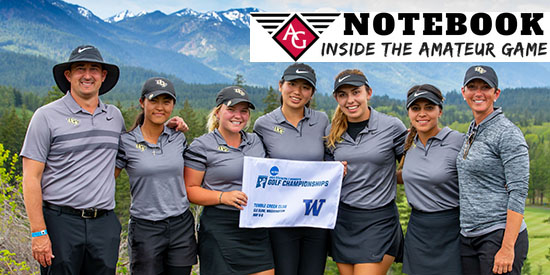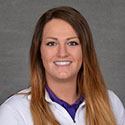
UCF's winning team (UCF Athletics photo)
Where NCAA postseason is concerned, there’s always a bit of luck involved. For the University of Central Florida, that didn’t come in terms of geography, but rather in logistics. You can’t get much farther from UCF’s Orlando campus than Cle Elum, Wash., where UCF was slotted to play an NCAA Regional.
In fact, when the regional announcements were made, head coach Emily Marron fielded this question from her team: Washington…as in, D.C.?
“When it popped up on the screen, I was a little shocked because I don’t think we’ve ever gone anywhere but east,” Marron said of her initial reaction to the regional selection show. “But in college golf, you have to embrace all these different adventures and experiences.”
That, and you have to hope that your travel goes as planned. It went so well for the Knights that Marron felt like sending her travel coordinator flowers, especially after she found out that another east-coast team had an almost 24-hour travel delay.
“I think any team that advances through to nationals, it’s hard to do. Everything has to go right,” Marron said.
UCF slipped into postseason with one of the last at-large bids. Marron’s team took the sixth and final qualifying spot in Cle Elum by a one-shot margin. When UCF tees it up at Blessings Golf Club in Fayetteville, Ark., this week for the NCAA Women’s Championship, it will be for the first time since 1996.
In Marron’s seven seasons in Orlando, UCF has qualified for regionals as a team five times.
Until May, “everything going right” isn’t the phrase you’d likely use to describe UCF’s season. The Knights’ first two starts out of the gate this fall were 11th and 12th. UCF won the next event, but the team’s head-to-head ranking had taken an immediate hit. Another 11th and another 12th followed in the spring.
“We just kept telling them to do what you can and let the rankings take care of themselves,” Marron said.
It helped, too, that she found a lineup that clicked. That happened mid-February when UCF won the Moon Golf Invitational by taking a one-shot co-lead into the final round and making it a nine-shot victory.
There’s a gritty underdog culture at UCF, a university that’s only existed for 56 years. Eight Knights teams made the NCAAs finals in the 2018-19 season – including a football team that went 12-1 and a basketball team that not only made the NCAA bracket but gave Duke a legitimate second-round scare. Marron wants women’s golf to be a part of that. She draws players that want to be a part of that, too.
“My main dream was to play college golf and play for a team that can compete for a national championship and here we are,” said Ana Laura Collado, who led UCF in Washington with a tie for second. Collado, a sophomore from Mexico, played the second round of the regional with countrywoman Maria Fassi, a senior from Arkansas who is arguably the most powerful player in women’s college golf this season. Collado tied her with even-par 72.
The numbers and the history alone made UCF look like a long shot in Cle Elum, but Marron used it as fuel. She stopped her team on No. 13 tee during the practice round and had a pep talk. UCF was the No. 13 seed, and there’s some history there: Only one No. 13 seed had ever advanced out of regionals before.
“We just have to believe that we’re going to be standing here tomorrow taking our picture…right at this spot tomorrow, advancing to the national championship,” Marron told her players after the second round, when UCF was in the sixth position.
UCF is a team of long-hitters that like the green light to be aggressive. The Cle Elum region was filled with scorers – most notably top-seeded USC, which won its 13th NCAA regional by getting double digits under par and leaving the next team 15 shots back. Tumble Creek Club is a course built for scoring with three par 5s on the back nine that players can go for. UCF played them in 4 under on the final day and played the back nine in 8 under.
“It takes a lot of guts, and they knew. They knew the last few holes, they could tell by me and (assistant coach Steve Sims) telling them they needed to make birdies, and they handled it really well,” Marron said.
Collado certainly knew coming down the stretch in UCF's anchor position. She launched a 3-wood from 260 yards out on the closing par 5 and came up 20 yards short. Collado lingered in the fairway, waiting for her coaches to come to her, but they didn’t.
“When I am in the zone, they prefer for me to stay in the zone,” she said. Collado hit “probably the best chip of the entire tournament” on her own and converted one final birdie. It was exactly what UCF needed to advance by one.
• • •
HERO OF THE WEEK: Standing on the first hole of a team playoff for a spot in the Division II national championship, Haley Tollette’s most pressing issue was which of her golf clubs were absolutely essential on the upcoming hole. Tollette was desperate to play it, but had to find a way to balance her golf bag on her back while using crutches to get from tee to green.
It’s not your average postseason scene, but it’s a fitting picture for the lengths a college athlete will go to for her sport.
Tollette, a senior and the leading scorer for Minnesota State, had gone down earlier that day on the 21st hole of the NCAA Division II Women’s Central Regional with a knee injury. She was reading a putt on the third hole of the second round when she heard her right knee crack and knew she couldn’t get back up. Tollette had torn her ACL while skiing in January 2018, and had been on a physical therapy regimen for a year and half to try to finish her college golf career without issue.

|
Haley Tollette
|
At first, head coach Bryant Black thought Tollette was joking. As he helped her line up the putt, her told her to try walking it off. After a few minutes on the third green, both realized it was a round ender.
“You’re on a golf course, you don’t expect to see things like that happen,” Black said. “At least in my four years as a player and six as a coach, I’d never experienced anything like that.”
The swelling was instant, and Tollette spent the rest of a 36-hole day sitting on the clubhouse patio watching her teammates fight for a spot in the national championship. Minnesota State hadn’t been since 2010. But if Tollette couldn’t be in the lineup that day, she was at least the spark they needed.
“They kind of went into attack mode and one of our girls went birdie birdie right away, another girl started her next round with three birdies in a row,” Black said. It was enough to play their way into a team playoff with Central Missouri for the fourth and final spot.
With the swelling down, Tollette thought she might be able to gut out a few swings in the playoff. It started on a par 4, so Tollette took her golf bag out of the push cart she normally uses (to minimize the stress on her knee) and tried lightening it as best she could. She removed all her fairway woods and planned to leave her driver on the tee after that first swing.
“I just thought if I could play one hole and maybe get a bogey or a par, that would help them,” she said.
At least that was the plan. The initial drive nearly sent her to the ground again, and Tollette was done. Minnesota State went three extra holes with Central Missouri to the point that darkness became a real issue. Central Missouri won on the third extra hole.
“I think that amount of intensity and pressure maybe eventually just came to a head,” Black said. “Walking off the golf course, I don’t think I’ve ever been more proud of a group of people in my life.”
As for Tollette, a public health major, surgery awaits, then she hopes to turn professional and get her PGA certification through the Minnesota Golf Association.
Editor’s note: Tollette’s teammate Alissa Carlson qualified for the national championship as an individual.
• • •
Q-SCHOOL CHANGE FOR THE BETTER…OR IS IT? Months have passed since the LPGA debuted its new Q-Series in October, but the shockwaves are still being felt across college golf. Alabama, runner-up at last year’s NCAA finals, didn’t even make the postseason after losing two players mid-season. Wake Forest and Arkansas are sitting pretty after each had a top player defer a card (another new option in 2018).
Many of the top collegians entered the Q-Series last fall simply because they could. A new exemption sent the top 5 players in the
Golfweek/Sagarin College Rankings (as of the end of the 2017-18 season) straight to the last of three Q-School stages. It was an opportunity that was hard to pass up.
In 2019, changes to the LPGA qualifying process remove that exemption. Instead, those five players, along with any player in the top 5 in the World Amateur Golf Ranking as of the entry deadline (Aug. 12), will be exempt into the second stage of Q-School instead.
It’s not the glittering opportunity that it was before for amateurs, and there’s another caveat: Players who still decide to take advantage of that pass will end up missing more of the fall season. The second stage will be played Oct. 14-17 in Venice, Fla.
• • •
TOURNAMENTS TO WATCH:
NCAA men’s regionals, various sites, May 13-15
The skinny: Six 54-hole regional tournaments will be conducted May 13-15 at six sites across the country: TPC Myrtle Beach (S.C.): University of Georgia Golf Course, Athens, Ga.; University of Louisville (Ky.) Golf Club; Stanford (Calif.) Golf Course; University of Texas Golf Club, Austin, Texas; Palouse Ridge Golf Club, Pullman, Wash.. Thirteen teams and 10 individuals not on those teams will compete at each of three regionals while the other three regionals will have 14 teams and five individuals not on those teams. The low five teams and the low individual not on those teams from each regional will advance to the finals.
U.S. Senior Women’s Open, Pine Needles Lodge & Golf Club, Southern Pines, N.C., May 16-19
The skinny: The second edition of this USGA championship includes 33 amateurs and expanded TV time. The final two rounds will be broadcast on FS1 on May 18 and May 19 from 3-5 p.m. ET.
• • •
STAT OF THE WEEK: Or list, rather
A very efficient list of junior golfers who have navigated their way through U.S. Open local qualifying. (
Also visit our complete list here.)
• • •
TWEET OF THE WEEK: Make that four days…